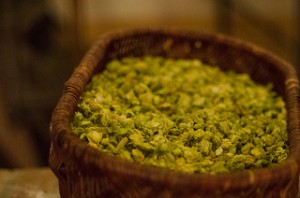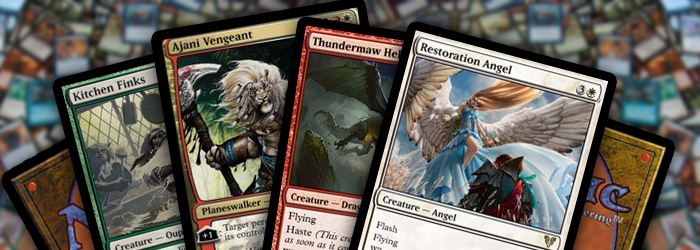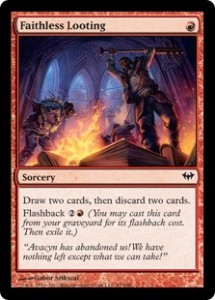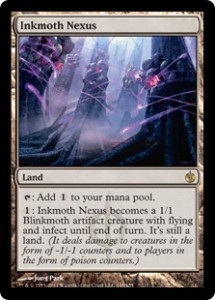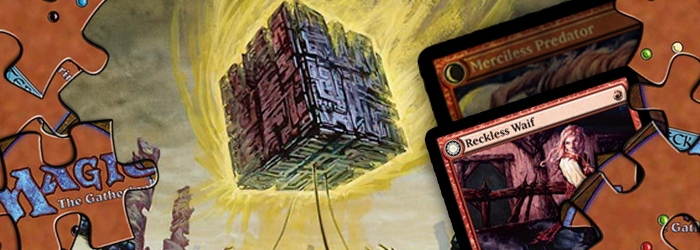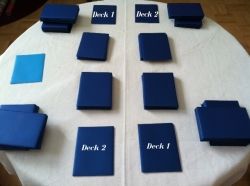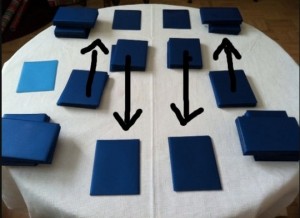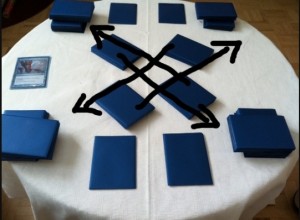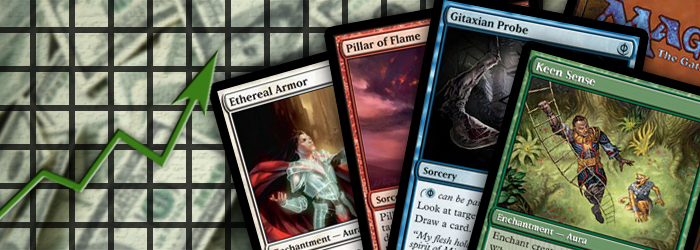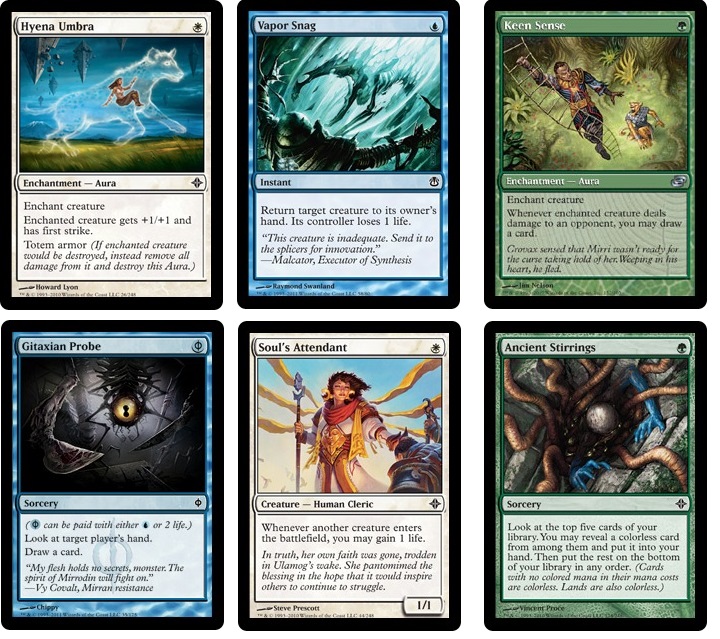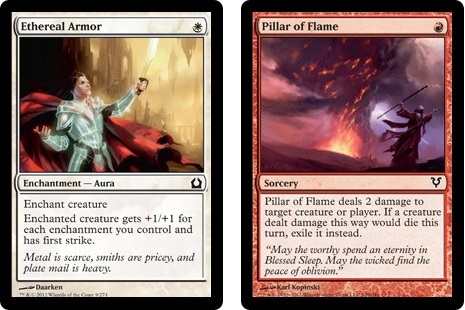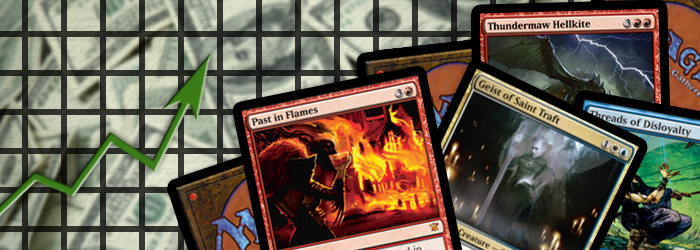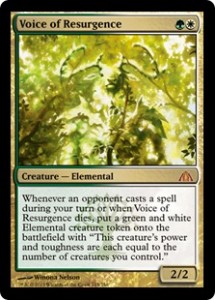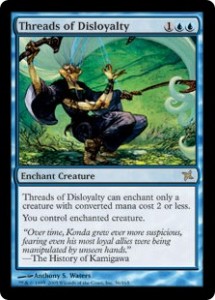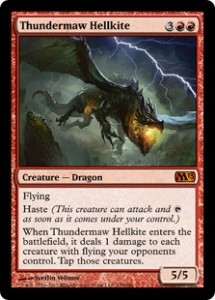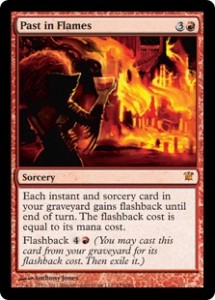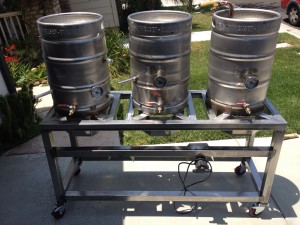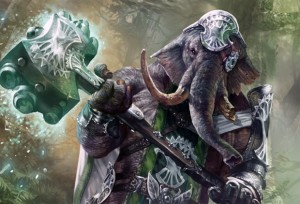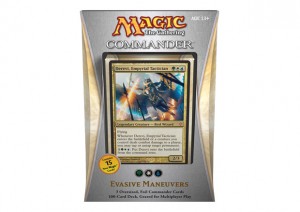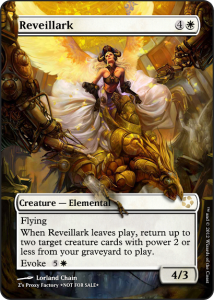Sometimes when you’re brewing, you strike gold with the first draft of your first list, and that’s exactly what happened here. I knew I wanted to brew a mono-green aggro/devotion deck that could easily abuse [card]Aspect of Hydra[/card]. As I feverishly began scribbling cards down that were reasonable in it, it began to feel more and more like the Dungrove Stompy list that I won a PTQ with, which excited me even further.
[deck title= Dungrove Stompy]
[Creatures]
4 Birds of Paradise
4 Llanowar Elves
4 Strangleroot Geist
4 Dungrove Elder
1 Champion of Lambholt
1 Borderland Ranger
2 Thrun, the Last Troll
3 Phyrexian Metamorph
1 Bellowing Tanglewurm
1 Wolfir Silverheart
1 Thragtusk
1 Acidic Slime
[/Creatures]
[Spells]
4 Green Suns Zenith
4 Rancor
2 Garruk Relentless
[/Spells]
[Land]
23 Forest
[/Land]
[Sideboard]
1 Melira Sylvok Outcast
3 Torpor Orb
2 Dismember
2 Beast Within
2 Crushing Vines
2 Fresh Meat
1 Thragtusk
2 Overrun
[/Sideboard]
[/deck]
There was nothing that could make it quite as consistent as the Dungrove Stompy list that I played, but I felt like I could make up for that with the redundancy of the two-drop slot of [card]Kalonian Tusker[/card] and [card]Swordwise Centaur[/card] to consistently have bigger starts that my opponents. After finishing my brewing articles from the last couple weeks, I acquired all the cards I needed for this deck and ran it through some testing. Without a sideboard, the deck beat Mono-Black Devotion 2-1, but unfortunately went 0-4 against an unorthodox UW Control deck running [card]Archangel of Thune[/card] in the main. Now I knew where I needed to focus my sideboarding strategy, which led me to this:
[deck title= Beast Wars]
[Creatures]
4 Elvish Mystic
4 Experiment One
4 Swordwise Centaur
4 Kalonian Tusker
4 Boon Satyr
4 Reverent Hunter
2 Polukranos, World Eater
3 Nylea, God of the Hunt
[/Creatures]
[Spells]
4 Aspect of Hydra
2 Bow of Nylea
2 Enlarge
[/Spells]
[Land]
3 Mutavault
20 Forest
[/Land]
[Sideboard]
2 Pithing Needle
3 Mistcutter Hydra
2 Plummet
2 Witchstalker
4 Nylea’s Disciple
2 Primeval Bounty
[/Sideboard]
[/deck]
Unfortunately, that was the extent of my testing with the deck before an event at Empire Game Center, which was to be my real testing for a PTQ in North Canton the following week. We got underway and it was announced that there were 81 players, meaning a total of seven rounds with a cut to top eight.
Round 1: B/R Midrange 2-0
Game 1 – I started off pretty quick while he played a couple swamps. On turn three, he finally played a [card]Lifebane Zombie[/card], and I followed it up with a [card]Bow of Nylea[/card]. I proceeded to keep dropping threat after threat, to which he responded by casting a [card]Dreadbore[/card] and an [card]Anger of the Gods[/card], but it wasn’t enough to stop me.
Game 2 – I started off even faster this time, but my opponent did even less this game. He cast a [card]Hero’s Downfall[/card] on turn three and followed it up with a [card]Desecration Demon[/card] on turn four, which I tapped down with a sacrificed [card]Mutvault[/card]. His next turn he was sitting at seven with the [card]Desecration Demon[/card] staring at my board of a 5/5 [card]Reverent Hunter[/card], a [card]Kalonian Tusker[/card], and a 2/2 [card]Experiment One[/card], and he tapped out for a [card]Whip of Erebos[/card] which allowed me to sacrifice the [card]Experiment One[/card] to tap down his [card]Desecration Demon[/card] and end the game.
Sideboarding: From what I saw, I assumed this was Mono-Black Devotion with red for cards [card]Dreadbore[/card] and [card]Anger of the Gods[/card], so I sideboarded only partially for Mono-Black Devotion.
In:
2 [card]Witchstalker[/card]
2 [card]Primeval Bounty[/card]
Out:
2 [card]Aspect of Hydra[/card]
2 [card]Enlarge[/card]
Round 2: Bant Control 2-0
Game 1 – I kept a fairly slow hand, but was able to make him one for one me until he ran out of cards and I was left with a couple of fatties to finish him off.
Game 2 – He was able to keep me off balance with a [card]Last Breath[/card] into [card]Kiora, the Crashing Wave[/card] and then [card]Jace, Architect of Thought[/card]. Fortunately, I was able to keep some pressure on and killed his [card]Jace, Architect of Thought[/card] with a [card]Mistcutter Hydra[/card] for one when he decided to use it to draw some cards. Once that happened, I was able to kill [card]Kiora, the Crashing Wave[/card] to free up my big guys and take the match.
Sideboarding: This is my standard plan going in for U/W Control decks, and it seemed to be fine in this matchup as well.
In:
2 [card]Pithing Needle[/card]
3 [card]Mistcutter Hydra[/card]
2 [card]Witchstalker[/card]
2 [card]Primeval Bounty[/card]
Out:
1 [card]Reverent Hunter[/card]
4 [card]Aspect of Hydra[/card]
2 [card]Bow of Nylea[/card]
2 [card]Enlarge[/card]
Round 3: RUG Devotion 2-1
Game 1 – I opened with a very aggressive start, but he had [card]Turn // Burn[/card] and [card]Cyclonic Rift[/card] to slow me down. That didn’t last for long, as I was eventually able to outmaneuver him with bigger guys.
Game 2 – My sideboard plan really took away from my aggressiveness this game and he was able to assemble a planeswalker army to stall me out. He then cast a [card]Progenitor Mimic[/card] copying my [card]Reverent Hunter[/card] to keep making guys that were too big for me to handle.
Game 3 – I absolutely just ran my opponent over this game, opening on [card]Experiment One[/card] into [card]Kalonian Tusker[/card] into [card]Reverent Hunter[/card] for three (since he cast [card]Turn/Burn[/card] on the [card]Experiment One[/card] during combat) and finishing up with a [card]Polukranos, World Eater[/card] to force the victory.
Sideboarding: I sideboarded like this had more blue than it actually did, and realized it during game two, so I desideboarded and went with the original configuration.
In:
3 [card]Mistcutter Hydra[/card]
2 [card]Witchstalker[/card]
Out:
3 [card]Aspect of Hydra[/card]
2 [card]Enlarge[/card]
Round 4: R/W Burn 2-1
Game 1 – I knew this opponent was on a red deck going into the match, but didn’t realize it was the full-on burn deck. I started with a bit of a slow hand and he ran out a [card]Young Pyromancer[/card] and then a [card]Chandra’s Phoenix[/card]. I was sitting on lethal damage for him on the next turn when he burned me down to four, untapped, and cast a [card]Warleader’s Helix[/card] to finish me off.
Game 2 – I kept another slow hand, but this time with a [card]Bow of Nylea[/card] and [card]Nylea’s Disciple[/card] to gain back much of the expected life loss. And in the end, it came down to me having [card]Boon Satyr[/card] to flash in and block his [card]Satyr Firedancer[/card], allowing me to live to kill him on the next turn.
Game 3 – This was another slugfest, with me keeping a slower hand full of lifegain. This time it was simply his deck failing him as he hit three lands in a row to not be able to kill me in time.
Sideboarding: I sideboarded under the assumption that my opponent had some bigger stuff that would be slow enough for me to resolve a [card]Primeval Bounty[/card], in game three I took them back out for two [card]Aspect of Hydra[/card].
In:
4 [card]Nylea’s Disciple[/card]
2 [card]Primeval Bounty[/card]
Out:
4 [card]Aspect of Hydra[/card]
2 [card]Enlarge[/card]
Round 5: R/G Monsters 2-0
Game 1 – I kept a very beefy hand with a lot of [card]Kalonian Tusker[/card]s and [card]Swordwise Centaur[/card]s and was able to run over everything he was throwing in the way.
Game 2 – Now this was a game! He went turn-two double [card]Burning-Tree Emissary[/card] into [card]Sylvan Caryatid[/card], then on turn three played a [card]Nykthos, Shrine to Nyx[/card] to cast a [card]Nessian Wilds Ravager[/card]. I let him choose between a [card]Kalonian Tusker[/card] and [card]Elvish Mystic[/card] to fight, and he chose the [card]Kalonian Tusker[/card]. I ran out a couple more small guys on my turn, to which he followed up with a turn four [card]Sylvan Primordial[/card] blowing up one of my [card]Mutavaults[/card]. I then cast another creature into an 8/8 [card]Reverent Hunter[/card] to stonewall his big guys for a while. I eventually cast a [card]Polukranos, World Eater[/card] and he followed up with his own. He activated monstrosity for seven to try to kill mine, only to have me cast [card]Aspect of Hydra[/card] to kill his instead. From there, I was able to start attacking with my giant [card]Reverent Hunter[/card], having him lose a lot of ground by repeatedly chump blocking it and eventually losing his big guys to it. He was able to cast another [card]Polukranos, World Eater[/card] to kill off two more guys and block and kill my [card]Reverent Hunter[/card], but at that point it was too late for him and he was grasping at straws trying to topdeck anything relevant to no avail.
Sideboarding: I pretended to sideboard, and even shuffled a few cards in and took them back out. There were no cards in my sideboard that I really wanted against this deck, the main was already pretty well setup for this match.
Round 6: Mono Black Devotion 0-0-3
I.D.
Round 7: Mono Black Devotion 0-0-3
I.D.
Top 8 Quarterfinals: Bant Control 1-2
Game 1 – I kept a very aggressive hand, and his only piece of interaction was a [card]Last Breath[/card]. He was unable to find a [card]Supreme Verdict[/card] to keep from dying.
Game 2 – I had an awkward hand with multiple [card]Swordwise Centaur[/card] that he was able to neuter with a [card]Detention Sphere[/card] and a couple [card]Supreme Verdict[/card]s. Once I did find some more creatures, he had already cast [card]Elspeth, Sun’s Champion[/card] to lock me out of the game.
Game 3 – I kept a hand of [card]Forest[/card], [card]Experiment One[/card], [card]Elvish Mystic[/card], [card]Swordwise Centaur[/card], [card]Swordwise Centaur[/card], and [card]Boon Satyr[/card] and opened on the [card]Experiment One[/card]. hoping to hit a [card]Forest[/card] to really get aggressive. Instead, I missed my land drop and played the [card]Elvish Mystic[/card], which promptly took its [card]Last Breath[/card]. I did draw a [card]Forest[/card] on my next turn and cast a [card]Swordwise Centaur[/card] so I could get in for two. He had another [card]Last Breath[/card] for my 2/2 [card]Experiment One[/card]. I then cast another [card]Swordwise Centaur[/card], getting them both [card]Detention Sphere[/card]d. His next turn, he cast a [card]Brimaz, King of Oreskos[/card], which I couldn’t get past. It eventually killed me.
Sideboarding: I sideboarded the same as I did earlier with the other Bant Control deck. I still feel like this was the right way to sideboard against this deck, but I may want something other than [card]Primeval Bounty[/card].
In:
2 [card]Pithing Needle[/card]
3 [card]Mistcutter Hydra[/card]
2 [card]Witchstalker[/card]
2 [card]Primeval Bounty[/card]
Out:
1 [card]Reverent Hunter[/card]
4 [card]Aspect of Hydra[/card]
2 [card]Bow of Nylea[/card]
2 [card]Enlarge[/card]
The rest of the top eight consisted of two Bant Control, three Mono-Black Devotion, one Esper Control, and one Mono-Blue Devotion.
I decided that I needed two better sideboard cards to replace [card]Primeval Bounty[/card] against the U/W/x decks, and since the card I really needed to deal with was [card]Elspeth, Sun’s Champion[/card], I decided on a [card]Bramblecrush[/card] and an additional [card]Pithing Needle[/card]. With those changes, I unleashed the deck upon an unsuspecting PTQ.
Round 1: U/G Biovisionary 2-0
Game 1 – This was a pretty straightforward game of me putting more pressure on than he could handle, but it did take longer because he was able to generate a ton of chump blockers. I was able to clinch it with an [card]Aspect of Hydra[/card] to end the game before his [card]Progenitor Mimic[/card] could spit out any extra [card]Biovisionary[/card]s.
Game 2 – I started with some early pressure again, but walked into an [card]Aetherize[/card], which was unexpected. I was quickly able to recover and end the game before he was able to find any more shenanigans.
Sideboarding: He got real excited talking about how many cards he was boarding in, so I correctly put him on boarding in a bunch of bounce spells and counterspells.
In:
3 [card]Mistcutter Hydra[/card]
2 [card]Witchstalker[/card]
Out:
3 [card]Aspect of Hydra[/card]
2 [card]Enlarge[/card]
Round 2: Mono-Black Devotion 2-0
Game 1 – I opened on my most aggressive start possible with a turn-one [card]Experiment One[/card], a turn-two [card]Krosan Tusker[/card], and a turn-three [card]Boon Satyr[/card]. All he was able to muster up was a [card]Pack Rat[/card] and a couple of removal spells that came far too late to be useful.
Game 2 – I had another opening close to the one from game one, but this time he got stuck on [card]Swamp[/card], [card]Mutavault[/card], and a [card]Pack Rat[/card] for the whole game. He was unable to interact at all.
Sideboarding:
In:
2 [card]Plummet[/card]
2 [card]Witchstalker[/card]
Out:
2 [card]Aspect of Hydra[/card]
2 [card]Enlarge[/card]
Round 3: R/G Monsters 2-0
Game 1 – I opened on [card]Experiment One[/card] and quickly made it a 2/2 to get in some damage, but my opponent was able to hide behind a turn-two [card]Courser of Kruphix[/card] for a couple of turns until I cast [card]Enlarge[/card] to run over his guys. It was another couple of turns and the second [card]Enlarge[/card] that sealed the victory.
Game 2 – He was able to get up a double-[card]Courser of Kruphix[/card] wall very early, but I managed to get another [card]Enlarge[/card] to remove the road blocks. Unfortunately, he was able to hit his big guys, keeping me at bay. I eventually hit [card]Bow of Nylea[/card] plus [card]Nylea, God of the Hunt[/card] to get through for lethal. He tried to deactivate Nylea by activating monstrous on [card]Polukranos, World Eater[/card] in an attempt to kill my [card]Elvish Mystic[/card], only to get the hydra killed by an [card]Aspect of Hydra[/card] pumping the elf.
Sideboarding: I have no relevant cards to sideboard against this matchup.
Round 4: R/G Monsters 2-1
Game 1 – I was able to outmaneuver his slow start, but his army eventually grew large enough to keep me at bay. I finally drew an [card]Aspect of Hydra[/card] to deal the final points of damage.
Game 2 – I kept an awkward hand of two [card]Forest[/card],s two [card]Experiment One[/card]s, two [card]Elvish Mystic[/card]s, and a [card]Nylea, God of the Hunt[/card], figuring that I would draw some big guys to evolve the [card]Experiment One[/card]s. But I drew mostly [card]Forest[/card]s and got blown out by his turn-four [card]Mizzium Mortars[/card]. I was unable to recover.
Game 3 – I had a super aggressive start again with [card]Experiment One[/card] into [card]Kalonian Tusker[/card] into [card]Reverent Hunter[/card]. He played a couple of blockers, but it was over before it began for him.
Sideboarding: I have no relevant cards to sideboard against this matchup.
Round 5: G/W Aggro 2-1
Game 1 – I opened quickly again, but he kept pouring the blockers in the way. In the end it came down to me mowing stuff down with a giant [card]Reverent Hunter[/card] that gained trample from [card]Nylea, God of the Hunt[/card], despite his [card]Ajani, Caller of the Pride[/card], buffing his already-big guys each turn.
Game 2 – This game started in my favor until he slammed down guys way bigger than mine for three turns, I finally got him into a stalemate when he hit a [card]Brave the Elements[/card] to kill me on the spot.
Game 3 – We both mulliganed, and instead of going to five, I kept a one-land hand that was bonkers when I hit a second land. This game was quickly over when I hit my second land off the top to cast a [card]Swordwise Centaur[/card] evolving [card]Experiment One[/card] and he was unable to find a second land. I followed up with two more [card]Swordwise Centaur[/card] to ensure he had no outs, and he hit a second [card]Forest[/card], but was still unable to do anything.
Sideboarding: I have no relevant cards to sideboard against this matchup.
Round 6: Bant Control 2-1
Game 1 – I opened pretty aggressively, but he had all the right cards. I did get him as low as eight life before he clinched the game with an [card]Elspeth, Sun’s Champion[/card] to keep me from ever getting in again.
Game 2 – I opened a little less aggressively, but with an awkward draw for him to play against. I put him of the backfoot and then cast a [card]Pithing Needle[/card], naming the only card that beats me in this situation… [card]Kiora, the Crashing Wave[/card]. After the match, I found out that he did in fact have the [card]Kiora, the Crashing Wave[/card] in hand.
Game 3 – I opened super aggressively and put an early [card]Pithing Needle[/card] on [card]Elspeth, Sun’s Champion[/card] so he would have to deal with it if he ever wanted to use her. Doing this allowed me to resolve a [card]Nylea, God of the Hunt[/card], which he had to [card]Detention Sphere[/card], allowing me to cast a second one. He had to [card]Detention Sphere[/card] the second one as well, keeping him from using any of his card-draw spells. He ended up missing a land drop because of the lack of filtering, and then drew a scry land the next turn, leaving him dead because he couldn’t cast his [card]Elspeth, Sun’s Champion[/card].
Sideboarding:
In:
3 [card]Mistcutter Hydra[/card]
3 [card]Pithing Needle[/card]
2 [card]Witchstalker[/card]
1 [card]Bramblecrush[/card]
Out:
4 [card]Aspect of Hydra[/card]
2 [card]Bow of Nylea[/card]
1 [card]Reverent Hunter[/card]
2 [card]Enlarge[/card]
Round 7: B/W Midrange 0-0-3
I.D.
Round 8: Mono Black Devotion 0-0-3
I.D.
Top 8 Quarterfinals: Mono Black Devotion 1-2
Game 1 – I mulliganed to six, and kept a fairly mediocre hand. I was punished pretty quickly for it as my opponent had turn-one and turn-three [card]Thoughtseize[/card] backed by turn-four and -five [card]Desecration Demon[/card]s
to finish me off.
Game 2 – I kept a fairly fast hand, and was able to outpace him while he tried to get advantage with a [card]Nightveil Specter[/card]. He ended up casting a [card]Desecration Demon[/card], and I locked it down to swing for the win.
Game 3 – I kept a pretty awful hand of four [card]Forest[/card], [card]Plummet[/card], [card]Bow of Nylea[/card], and a [card]Nylea, God of the Hunt[/card], thinking I could attack him from a different angle. Unfortunately, he took my [card]Plummet[/card] with a [card]Thoughtseize[/card] and I drew four more [card]Forest[/card]s and another [card]Nylea, God of the Hunt[/card] as five of my next six draws. He quickly destroyed me with two [card]Desecration Demon[/card]s while I was unable to do anything.
Sideboarding:
In:
2 [card]Plummet[/card]
2 [card]Witchstalker[/card]
Out:
2 [card]Aspect of Hydra[/card]
2 [card]Enlarge[/card]
I was once again very happy with my deck. There were quite a few people in absolute shock that a mono-green deck was doing well, including some of my friends. As far as any further changes to the deck, after a combined record of 11-2-4 across two tournaments, I think I’ve nailed down the optimal build for now.
I would recommend this deck to anyone looking to get into Standard fairly cheaply, as the [card]Mutavault[/card]s are the only cards worth more than $10 currently, and they’re not absolutely necessary if you just want to have fun.
As always, if you have any questions or comments, please feel free to leave them for me and I will try to get back to everyone.
Thanks for reading,
Josh Milliken
@joshuamilliken









